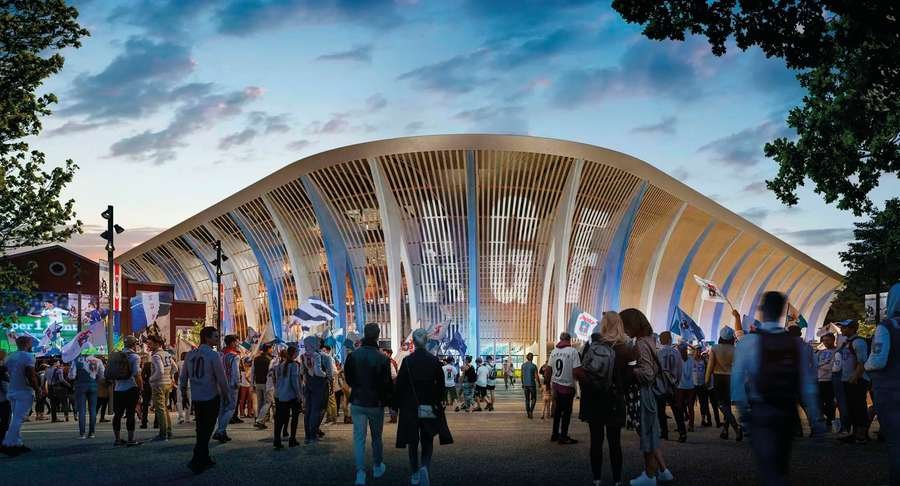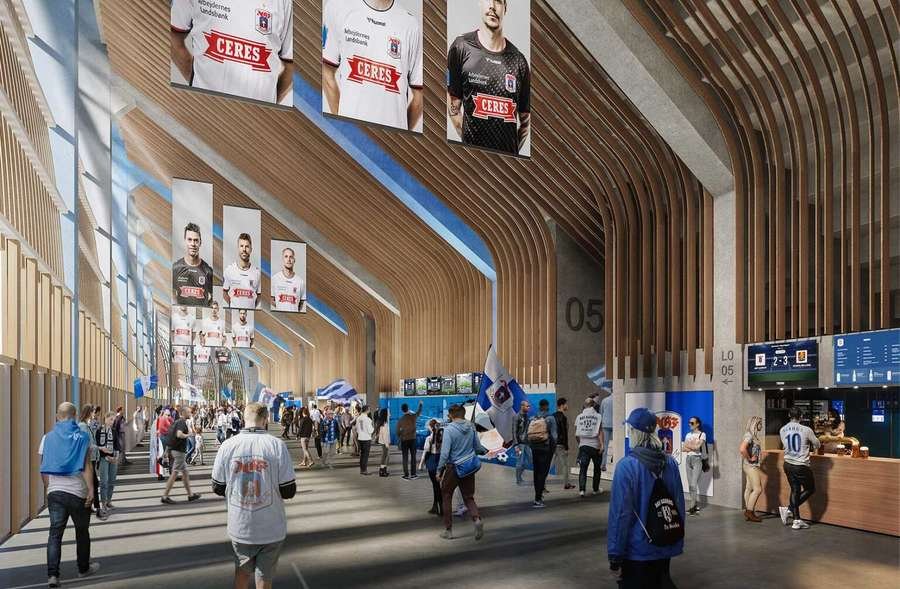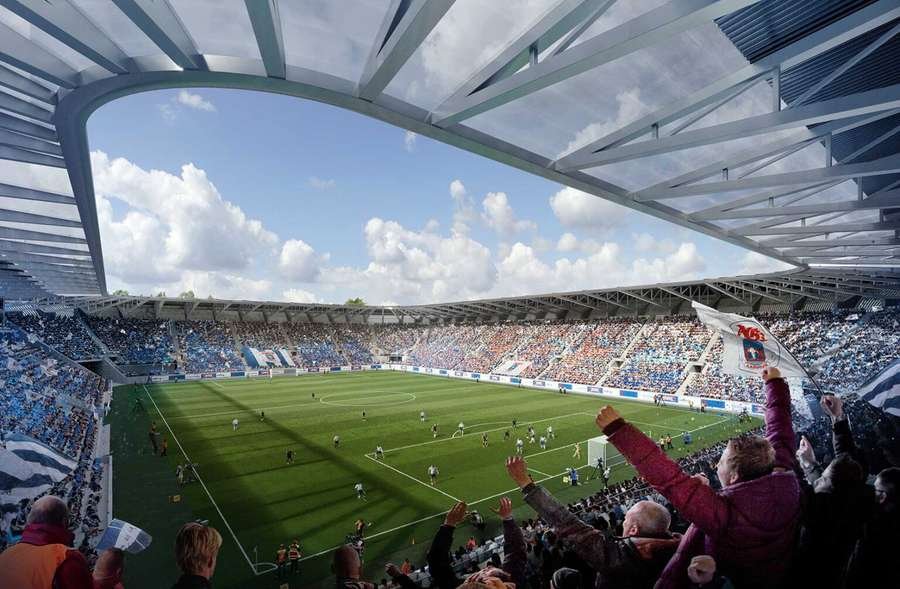After a lengthy two-decade wait, AGF finally revealed its plans for a new stadium, with CEO Jacob Nielsen touting the development as the crucial means to level up the club’s challenge against FC Midtjylland and FC Copenhagen for the Danish title. Unfortunately, significant cost overruns, delays in construction, difficulties securing permits, and ongoing disputes among local politicians and football officials have transformed this project into a cautionary tale on how not to embark on a stadium project.
The stadium site in Aarhus is situated at the end of a picturesque avenue, bordered by trees lining a small road in a serene neighbourhood that marks the gateway to the Marselisborg forest.
It’s hard to find a stadium in Europe where the surroundings are as enchanting as those found in Aarhus, and the existing tranquility starkly contrasts with the turmoil that has plagued the new stadium’s planning process.
The existing stadium underwent renovations between 1999 and 2001, but it has faced ongoing issues that marred the spectator experience. Outdated facilities for players and VIPs, coupled with an athletics track surrounding the pitch, detracted from the fan experience. Moreover, its partially covered bowl with exposed edges rendered attending matches a rather chilly affair for spectators.
For nearly ten years, there has been considerable debate over how and where to rebuild, with football authorities, politicians, and the public grappling to find common ground.

‘The Arena of the Forest’
Late in 2022, AGF, in collaboration with the municipality of Aarhus and investors, unveiled their vision for ‘The Arena of the Forest’. This ambitious project aims to provide Denmark with a modern, 24,000-seat stadium that would enhance the country’s portfolio for hosting tournaments and events.
Retained at the same site as the existing stadium, the new venue is to be designed by the esteemed London-based Zaha Hadid Architects, known for iconic works such as the London Aquatics Centre for the 2012 Olympics and Qatar’s Al Janoub Stadium for the 2022 World Cup.
Projected for completion in early 2026 at a cost estimated at 750 million Danish kroner (around 100 million euros), AGF planned to play all home games at a temporary stadium facility in Vejlby, one of Aarhus’ suburbs, until then.
Initially, excitement abounded — AGF would finally enjoy the privilege of performing in a purpose-built football stadium, creating a solid foundation for their aspirations of winning the Danish title. However, this optimism quickly faded as construction began, bringing with it a slew of unforeseen complications.
In February 2024, the project’s engineering consultants warned that the existing stadium was effectively built on marshy ground, leading to concerns about the stability of the new structure. While stabilisation measures could be implemented, they would inevitably delay the project by at least six months. This was merely the tip of the iceberg of the challenges that beset the project.

33 million euros in debt
When Mayor Jacob Bundsgaard participated in the launch of the new stadium project, he remarked on Aarhus’ legacy of adhering to budget forecasts.
Two years later, however, he inexplicably resigned just a week before it was revealed that the project costs had escalated by a staggering 250 million Danish kroner (roughly 33 million euros).
Initially, the stadium’s planning aimed to ensure that the municipal budget would not face any detriment due to construction costs. A total of 650 million Danish kroner (87 million euros) had been secured for the stadium’s construction, with 500 million kroner (67 million euros) sourced from sponsors Lind Invest and Salling Fond, while AGF was prepared to contribute the remaining 150 million kroner (20 million euros).
This left Aarhus municipality to allocate just 250 million kroner (33 million euros) for the development of the surrounding facilities as part of the overall project plan.
Upon disclosing that the project was 250 million kroner ‘in debt’, the municipality cited the area’s soft soil as a contributing factor to the financial overruns. However, this is only part of the story as extraordinary quality materials significantly inflated building costs.
The costs were particularly high for the VIP area, earmarked for features uncommon in Danish stadiums. Additionally, it turned out that far more materials than initially anticipated were required.

AGF Faces Financial Challenges
Following the revelation of escalating costs, the city council has placed blame on the former mayor for prolonging their lack of communication about the budget increases.
As the project now stands with a 250 million kroner debt, former celebrations over the prospective stadium have faded, leaving three parties embroiled in a blame game.
AGF contends that the mayor and council have placed them in a position where they might be compelled to play in a small temporary sports facility for years, resulting in substantial revenue losses.
Politicians are trading jabs, evading accountability, while the public’s ire is directed at both AGF and the municipality, as citizens may end up footing the bill for these costly missteps through cutbacks to essential services.
On top of that, there is now speculation that AGF may not be able to afford to play in the new stadium upon its completion.
A rental agreement between Aarhus municipality and AGF for the stadium remains unfinalised. Initially, a contract was drawn up requiring AGF to pay 7.3 million Danish kroner (approximately 970,000 euros) annually over 30 years; however, the Danish Social Appeals Board has not legalised this agreement.
Call for Greater Transparency
Currently, proposals have been made to reassess certain budget allocations related to the quality of the pitch, seating in the VIP area, and the stadium capacity, which was originally intended to host 24,000 spectators.
These proposals have incited backlash from AGF management, as both the stadium’s capacity and the VIP section are essential for the club’s financial viability in competing against FC Midtjylland and FC Copenhagen.
With numerous obstacles arising in the stadium’s construction, there are even murmurs about potentially scrapping the project; yet, given that the old venue is already under demolition, this hardly seems viable for AGF. Newly-elected Mayor Anders Winnerskjold has emphasised the need to see the project through to completion, stating:
“It’s a challenging scenario for a new Mayor. We could potentially abandon the project, but that would result in enormous costs. We’ve already invested significant resources; the demolition of the old stadium is progressing and considerable money has been spent,” said Winnerskjold.
“To reach our goal, we must ensure a greater level of transparency in the planning process, yet when we eventually take our seats in the new stadium, we hope to leave behind the pains of construction.”
Compiled by SportArena.com.au.
Fanpage: SportArena.com.au.
LiveScore – Live Sports Results & Odds.




